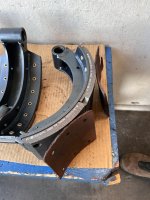Thanks that is helpful and sounds like good practice.
And you are correct in terms of priorities though there has been some big boxes checked recently.
Recently, the guys at Sacramento Spring were able to take my old broken spring and combine it with parts with an existing leaf spring to improve the alignment on the rear axel. It was off about 6.5. cm before from axel to axel! I'm hoping this removed the crab walk that the truck had.They are super rad guys and referred me to a mechanic who came out their lot and removed/reinstalled the leaf spring.

The plan was to meet up with that same guy this week to help with the damaged air lines and hydraulics on the front bumper. There are some big leaks around the PTO and cab lift that need to be addressed. But that didn't work out to I headed to Nevada between work shifts for help with an alignment and brakes. Finding a shop that could help with the brakes has been challenging. I've been hauling a set of brake liners and drums around with me for most of the year. I had stopped by John Spring and Suspension in Reno earlier. They are the ones that figured out the truck had asymmetrical lengthen leaf springs that were causing the crab walk. The guy that does the alignments ended up being sick this week but the owner let me use the lot and referred me to a Big Rig Mobile Repair for help.
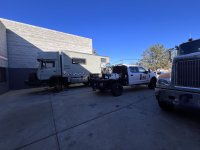
Just across the street is an old school shop that is literally the only place I could find that would install the liners on the shoes. After the shoes were removed, I simply walked them across the street and they had them ready in less than 2 hours! Not only that, they had cleaned them up and painted them.
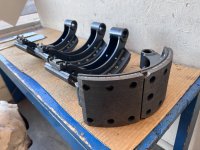
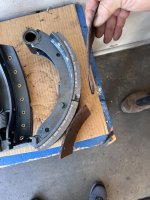
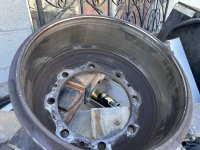
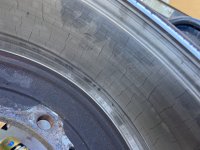
You can see the front brakes had gone critical who knows how long ago. One of the liners had even gotten down to the rivets and the drums were completely shot.

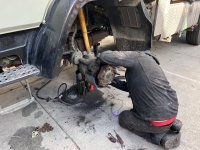
Unfortunately, the re-install wasn't uneventful. The new liners had so much thickness that the drums wouldn't cleared them. At this point, I was beyond grateful to be at that exact site vs having the shoes/liners shipped out. The owners from Reno Brake, walked over, looked at the problem, and simply took the shoes back to machine off a bit of material to clear the drums. This took them about 10-20 minutes total and they refused to charge me extra. In fact, they only changed me around $75 for reline/paint the shoes!!! After the brakes were fitted, I test drove the heffalump around the block and was very stoked to have solid front brakes. What a huge difference in driving and it really adds a very thick layer of safety. Afterward, I had to argue with the mechanic about pricing. He tried to under-bill me for his services. After some back and forth, we finally agreed on a bill that was nearly double what he tried to charge me originally.
While the work was being done. The oner of John Spring came out and chatted. He is a super rad, humble, and honest individual. He seasoned traveler that experienced the world in and out of the military. I really wanted to get a pic of him with the truck, but he was tied up with customers as I was leaving. I really can't overstate what a great feeling it is to have this work done through such a positive consumer experience. The rears will still need to be serviced at some point, the pads are worn unevenly and there is plenty of pad life for now. What a big relief it is to have these brakes serviced. The driving experience is like night/day and it's just that much more safer. If feels like some momentum is finally being created in getting this truck back to where it should be. I'll share more later and in the next post.









